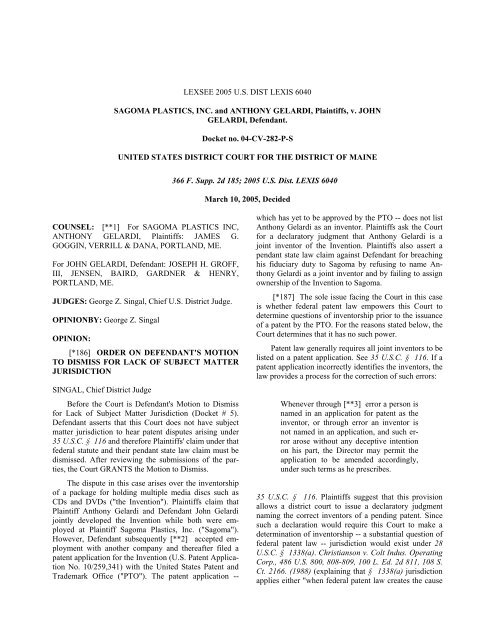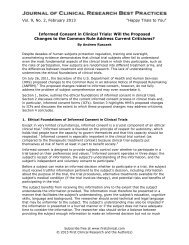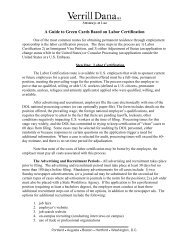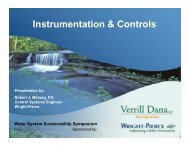Sagoma Plastics, Inc. and Anthony Gelardi v. John - Verrill Dana
Sagoma Plastics, Inc. and Anthony Gelardi v. John - Verrill Dana
Sagoma Plastics, Inc. and Anthony Gelardi v. John - Verrill Dana
You also want an ePaper? Increase the reach of your titles
YUMPU automatically turns print PDFs into web optimized ePapers that Google loves.
LEXSEE 2005 U.S. DIST LEXIS 6040SAGOMA PLASTICS, INC. <strong>and</strong> ANTHONY GELARDI, Plaintiffs, v. JOHNGELARDI, Defendant.Docket no. 04-CV-282-P-SUNITED STATES DISTRICT COURT FOR THE DISTRICT OF MAINE366 F. Supp. 2d 185; 2005 U.S. Dist. LEXIS 6040March 10, 2005, DecidedCOUNSEL: [**1] For SAGOMA PLASTICS INC,ANTHONY GELARDI, Plaintiffs: JAMES G.GOGGIN, VERRILL & DANA, PORTLAND, ME.For JOHN GELARDI, Defendant: JOSEPH H. GROFF,III, JENSEN, BAIRD, GARDNER & HENRY,PORTLAND, ME.JUDGES: George Z. Singal, Chief U.S. District Judge.OPINIONBY: George Z. SingalOPINION:[*186] ORDER ON DEFENDANT'S MOTIONTO DISMISS FOR LACK OF SUBJECT MATTERJURISDICTIONSINGAL, Chief District JudgeBefore the Court is Defendant's Motion to Dismissfor Lack of Subject Matter Jurisdiction (Docket # 5).Defendant asserts that this Court does not have subjectmatter jurisdiction to hear patent disputes arising under35 U.S.C. § 116 <strong>and</strong> therefore Plaintiffs' claim under thatfederal statute <strong>and</strong> their pendant state law claim must bedismissed. After reviewing the submissions of the parties,the Court GRANTS the Motion to Dismiss.The dispute in this case arises over the inventorshipof a package for holding multiple media discs such asCDs <strong>and</strong> DVDs ("the Invention"). Plaintiffs claim thatPlaintiff <strong>Anthony</strong> <strong>Gelardi</strong> <strong>and</strong> Defendant <strong>John</strong> <strong>Gelardi</strong>jointly developed the Invention while both were employedat Plaintiff <strong>Sagoma</strong> <strong>Plastics</strong>, <strong>Inc</strong>. ("<strong>Sagoma</strong>").However, Defendant subsequently [**2] accepted employmentwith another company <strong>and</strong> thereafter filed apatent application for the Invention (U.S. Patent ApplicationNo. 10/259,341) with the United States Patent <strong>and</strong>Trademark Office ("PTO"). The patent application --which has yet to be approved by the PTO -- does not list<strong>Anthony</strong> <strong>Gelardi</strong> as an inventor. Plaintiffs ask the Courtfor a declaratory judgment that <strong>Anthony</strong> <strong>Gelardi</strong> is ajoint inventor of the Invention. Plaintiffs also assert apendant state law claim against Defendant for breachinghis fiduciary duty to <strong>Sagoma</strong> by refusing to name <strong>Anthony</strong><strong>Gelardi</strong> as a joint inventor <strong>and</strong> by failing to assignownership of the Invention to <strong>Sagoma</strong>.[*187] The sole issue facing the Court in this caseis whether federal patent law empowers this Court todetermine questions of inventorship prior to the issuanceof a patent by the PTO. For the reasons stated below, theCourt determines that it has no such power.Patent law generally requires all joint inventors to belisted on a patent application. See 35 U.S.C. § 116. If apatent application incorrectly identifies the inventors, thelaw provides a process for the correction of such errors:Whenever through [**3] error a person isnamed in an application for patent as theinventor, or through error an inventor isnot named in an application, <strong>and</strong> such errorarose without any deceptive intentionon his part, the Director may permit theapplication to be amended accordingly,under such terms as he prescribes.35 U.S.C. § 116. Plaintiffs suggest that this provisionallows a district court to issue a declaratory judgmentnaming the correct inventors of a pending patent. Sincesuch a declaration would require this Court to make adetermination of inventorship -- a substantial question offederal patent law -- jurisdiction would exist under 28U.S.C. § 1338(a). Christianson v. Colt Indus. OperatingCorp., 486 U.S. 800, 808-809, 100 L. Ed. 2d 811, 108 S.Ct. 2166. (1988) (explaining that § 1338(a) jurisdictionapplies either "when federal patent law creates the cause
366 F. Supp. 2d 185, *; 2005 U.S. Dist. LEXIS 6040, **Page 2of action or . . . the plaintiff's right to relief necessarilydepends on resolution of a substantial question of federalpatent law.").Defendant rejects Plaintiffs' interpretation of 35U.S.C. § 116, arguing that it cannot be interpreted ascontaining a private right of action [**4] <strong>and</strong> shouldinstead be understood as a grant of exclusive authority tothe Director of the PTO. If § 116 does not contain a privateright of action, Defendant argues, this Court doesnot have subject matter jurisdiction to hear Plaintiffs'claims.The question of whether a federal statute that fails toexplicitly provide for a private right of action nonethelesscontains an implied private right of action is determinedby examining Congress' intent in enacting thestatute. See Thompson v. Thompson, 484 U.S. 174, 179,98 L. Ed. 2d 512, 108 S. Ct. 513 (1988). "Unless thiscongressional intent can be inferred from the language ofthe statute, the statutory structure, or some other source,the essential predicate for implication of a private remedysimply does not exist." Id. (quoting Northwest Airlines,<strong>Inc</strong>. v. Transport Workers Union, 451 U.S. 77, 94,67 L. Ed. 2d 750, 101 S. Ct. 1571 (1981)). While ananalysis of § 116 st<strong>and</strong>ing alone provides few clues as towhether Congress intended to create a private right ofaction, the comparison of § 116 to a parallel provisionrelating to issued patents makes it clear that Congress didnot intend the courts to adjudicate inventorship until aftera patent has issued.In addition [**5] to providing a process for correctinginventorship on submitted patent applications in 35U.S.C. § 116, federal patent law provides a process forcorrecting inventorship of an issued patent. Unlike theprocess described in § 116, the provision authorizing thecorrection of issued patents explicitly delineates a rolefor the courts as well as the Director:Whenever through error a person isnamed in an issued patent as the inventor,or through error an inventor is not namedin an issued patent <strong>and</strong> such error arosewithout any deceptive intention on hispart, the Director may, on application ofall the parties <strong>and</strong> assignees, with proof ofthe facts <strong>and</strong> such other requirements asmay be imposed, issue a certificate correctingsuch error.[*188] The error of omitting inventors ornaming persons who are not inventorsshall not invalidate the patent in whichsuch error occurred if it can be correctedas provided in this section. The court beforewhich such matter is called in questionmay order correction of the patent onnotice <strong>and</strong> hearing of all parties concerned<strong>and</strong> the Director shall issue a certificateaccordingly.35 U.S.C. § 256 [**6] (emphasis added). There can beno doubt from the above passage that Congress intendedthe courts to have the power to adjudicate inventorship ofa patent after the patent has issued.However, this clear delegation of power to thecourts in § 256 casts serious doubt upon the courts'power to adjudicate inventorship under § 116. It is obviousfrom the parallel language of § 116 <strong>and</strong> § 256 thatCongress drafted them to be complementary. The provisionscontain identical requirements of "error" on theapplication <strong>and</strong> lack of "deceptive intention" on the partof the nonjoined or misjoined inventor. The language ofthe two provisions diverges only insofar as the requirementsof each provision are substantively different.Given the structural parallels between the two provisions,it can be inferred that Congress' clear delegation ofpower to the courts in § 256 to correct issued patents<strong>and</strong> its failure to make any such express delegation in §116 indicates a conscious choice to bar the courts fromcorrecting errors regarding inventorship until after thepatent has issued.Interpreting § 116 as precluding a private right ofaction ensures a more rational <strong>and</strong> coherent process forprocessing [**7] patent applications. With no privateright of action under § 116, the PTO may still correctinventorship errors during the application process withthe consent of all inventors, n1 or it may reject the applicationoutright if consent cannot be obtained. However,the courts may not interfere with the patent process untilafter the PTO has rendered a final decision on the precisenature of the patent, if it chooses to issue a patent at all.Such a scheme ensures that potentially long <strong>and</strong> costlylitigation over the question of inventorship will not bemooted by subsequent actions of the PTO. If a privateright of action were implied in § 116, a court mightgrant relief to a plaintiff-inventor only to have the PTOdetermine that the particular claims in the applicationover which plaintiff claimed inventorship are not patentable.Or the PTO might deny the patent application inits entirety. It seems unlikely that Congress intended toauthorize a scheme in which such a waste of scarce judicialresources was possible.n1 See 37 C.F.R. § 1.48 (requiring an oath ordeclaration by all actual inventors that the cor-
366 F. Supp. 2d 185, *; 2005 U.S. Dist. LEXIS 6040, **Page 3rected application correctly states the original orfirst inventors); see also Iowa State UniversityFoundation v. Sperry R<strong>and</strong> Corp., 444 F.2d 406,408 n.1 (4th Cir. 1971).[**8]The Court's conclusion is also supported by caselaw. In Eli Lilly <strong>and</strong> Co. v. Aradigm Corp. the FederalCircuit stated in dicta n2 that § 116 "only grants the Directorof the Patent <strong>and</strong> Trademark Office the authorityto take certain actions <strong>and</strong> plainly does not create a causeof action in the district courts to modify inventorship onpending patent applications." 376 F.3d 1352, 1357 n.1(Fed. Cir. 2004). Similarly, in E.I. Du Pont de Nemours& Co. v. Okuley the Sixth Circuit upheld a districtcourt's dismissal of an inventorship claim under § 116for lack of jurisdiction. 344 [*189] F.3d 578, 584 (6thCir. 2003), cert. denied, 541 U.S. 1027, 158 L. Ed. 2d642, 124 S. Ct. 2071 (2004). The Okuley court comparedthe language of § 116 <strong>and</strong> § 256 <strong>and</strong> concluded thatCongress intended to draw a distinctionbetween patent applications <strong>and</strong> issuedpatents. While the patent is still in theprocess of gestation, it is solely within theauthority of the Director. As soon as thepatent actually comes into existence, thefederal courts are empowered to correctany error that the Director may havecommitted.U.S.C. § 1338(a) employed by the Supreme Court inChristianson, 486 U.S. at 808-09, to determine that theplaintiffs' request for a declaratory judgment of inventorship[**10] "implicates federal patent law provisionscovering inventorship on patent applications under 35U.S.C. § 116." Heineken, 103 F. Supp. 2d at 478. TheHeineken court did not discuss whether § 116 creates aprivate right of action for nonjoined inventors.Without a private right of action under § 116, Plaintiffs'claims must fail even if this Court has jurisdictionunder the Christianson analysis. n3 The statute establishingfederal patent law jurisdiction, like the statute establishingfederal question jurisdiction, does not createcauses of action. See Mead Corp. v. United States, 490F. Supp. 405, 407 (D.D.C. 1980), aff'd, 209 U.S. App.D.C. 253, 652 F.2d 1050 (D.C. Cir. 1981). It merelyallows federal courts to hear causes of action independentlycreated by Congress in federal patent law. Id. Sincethe Court chooses to follow the Federal Circuit <strong>and</strong> theSixth Circuit in holding that there is no implied privateright of action in § 116, the fact that 28 U.S.C. § 1338would provide this Court with jurisdiction to hear such acause of action, were it to exist, cannot save Plaintiffs'claims. The [**11] fact that Plaintiffs request declaratoryjudgment of inventorship rather than relief directlyunder § 116 does not alter this analysis. See MVC, <strong>Inc</strong>.v. King-Seeley Thermos Co., 870 F.2d 1568, 1571 (Fed.Cir. 1989) (noting that plaintiff erred in bringing a claimfor correction of inventorship on an issued patent as adeclaratory judgment action rather than under 35 U.S.C.§ 256).Id. The court noted the possibility of "premature" <strong>and</strong>[**9] "futile" litigation if putative inventors were allowedto sue prior to the approval of the patent application.Id.n2 The court's statement was dicta because itfound that the district court had constructivelyconverted plaintiff's claim to a § 256 claim whenthe patent in question was issued during thecourse of the litigation. See id.Plaintiffs point out that a h<strong>and</strong>ful of district courts,including one in the District of Massachusetts, have allowedinventorship claims under § 116 to go forward.See Heineken Technical Services v. Darby, 103 F. Supp.2d 476 (D. Mass. 2000); Post Performance, LLC v. RenaissanceImports, <strong>Inc</strong>., 333 F. Supp. 2d 834 (E.D. Mo.2004) (adopting the reasoning of Heineken). The Heinekencase employed the test for jurisdiction under 28n3 It is unclear whether the Heineken court implicitlydetermined that a private right of actionexists in § 116 or felt that Christianson made itunnecessary to find such a private right of action.Whichever the case, the Court declines to followthat decision.One final issue remains in this case, although it wasnot pressed by either of the parties. Defendant moved todismiss this claim under Federal Rule of Civil Procedure12(b)(1) for lack of federal subject matter jurisdiction.Although many of the cases on this issue have couchedtheir analysis [**12] in terms of jurisdiction under 28U.S.C. § 1338, the core of Defendant's argument is thatthe provision of federal patent law at issue does not providePlaintiffs with a cause of action for which relief canbe granted. In Steel Co. v. Citizens for a Better Environment,a case over the scope of the citizen-suit provision[*190] in the Emergency Planning <strong>and</strong> CommunityRight-To-Know Act of 1986, the Supreme Court ex-
366 F. Supp. 2d 185, *; 2005 U.S. Dist. LEXIS 6040, **Page 4plained that disputes over the interpretation of federal orconstitutional law generally go to the merits of a claimrather than jurisdiction:The absence of a valid (as opposed to arguable)cause of action does not implicatesubject-matter jurisdiction. . . . The DistrictCourt has jurisdiction if the right ofpetitioners to recover under their complaintwill be sustained if the Constitution<strong>and</strong> laws of the United States are givenone construction <strong>and</strong> will be defeated ifthey are given another, unless the claimclearly appears to be immaterial <strong>and</strong> madesolely for the purpose of obtaining jurisdictionor where such a claim is whollyinsubstantial <strong>and</strong> frivolous"523 U.S. 83, 89, 140 L. Ed. 2d 210, 118 S. Ct. 1003(1998) (citations omitted). Under this st<strong>and</strong>ard, [**13]dismissal under Rule 12(b)(1) is inappropriate when thecase hinges upon an arguable interpretation of federallaw. See Chiplin Enterprises, <strong>Inc</strong>. v. City of Lebanon,712 F.2d 1524, 1528 (1st Cir. 1983) (holding that dismissalshould occur under Rule 12(b)(6) rather than Rule12(b)(1) when a party's "right to recover depends on constructionof the Constitution <strong>and</strong> laws of the UnitedStates, <strong>and</strong> its claim is not so patently frivolous as not toinvolve a federal controversy").Since the issue of whether § 116 contains a privateright of action depends upon construction of federal law<strong>and</strong> Plaintiffs' argument that such a right exists is notwholly insubstantial <strong>and</strong> frivolous, this Court does havejurisdiction over Plaintiffs' claim. Indeed, "it has longbeen recognized that where a plaintiff asserts that a privateright of action is implied from federal law, federalcourts do have the requisite subject matter jurisdiction todetermine whether such a federal remedy exists." Arroyo-Torresv. Ponce Federal Bank, F.B.S., 918 F.2d276, 280 (1st Cir. 1990) (citation omitted); see alsoThompson v. Thompson, 798 F.2d 1547, 1550 (9th Cir.1986), [**14] aff'd, 484 U.S. 174, 98 L. Ed. 2d 512, 108S. Ct. 513 (1988) (holding that the District Court's dismissalof claims under the Parental Kidnapping PreventionAct because the statute does not contain a privateright of action should have come under Rule 12(b)(6),not Rule 12(b)(1)); Davis v. Monroe County Bd. ofEduc., 526 U.S. 629, 633-40, 143 L. Ed. 2d 839, 119 S.Ct. 1661 (1999) (applying Rule 12(b)(6) to decidewhether a private right of action exists). But see MassachusettsFed'n of Nursing Homes v. Massachusetts, 791F. Supp. 899, 900-901 (D. Mass 1992) (applying Rule12(b)(1) to decide whether a private right of action exists).Given the Court's finding that § 116 does not providePlaintiffs with a private right of action, Plaintiffs'claim must still be dismissed. However, the Court dismissesit for failure to state a claim under Rule 12(b)(6)rather than for lack of subject matter jurisdiction underRule 12(b)(1).Plaintiffs' remaining claim for breach of fiduciaryduty is a state law claim brought under the doctrine ofpendant jurisdiction. See 28 U.S.C. § 1367; United MineWorkers v. Gibbs, 383 U.S. 715, 725, 16 L. Ed. 2d 218,86 S. Ct. 1130 (1966). Since the Court has dismissed the[**15] only claim over which it has original jurisdiction,it declines to exercise supplemental jurisdiction overPlaintiffs' state law claim. See 28 U.S.C. § 1367(c).For the foregoing reasons, the Court GRANTS Defendant'sMotion to Dismiss <strong>and</strong> hereby ORDERS thatCount I be DISMISSED WITH PREJUDICE <strong>and</strong> CountII be DISMISSED WITHOUT PREJUDICE.SO ORDERED.George Z. SingalChief U.S. District JudgeDated this 10th day of March, 2005.Reproduced by <strong>Verrill</strong> <strong>Dana</strong>, LLP with the permission of LexisNexis. Copyright 2005.LexisNexis, a division of Reed Elsevier <strong>Inc</strong>. No copyright is claimed as to any portion of the original workprepared by a government officer or employee as part of that person's official duties.







